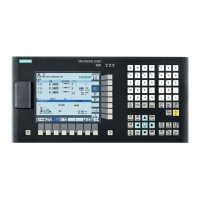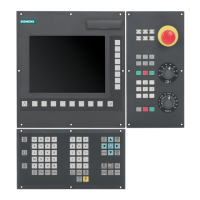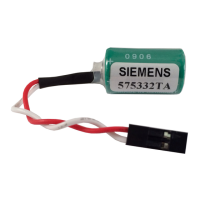This means that MD20270 $MC_CUTTING_EDGE_DEFAULT and MD20272 $MC_SUMCORR_DEFAULT
define, with the programming of T0 the value of D, DL.
For example, MD20270 $MC_CUTTING_EDGE_DEFAULT=1
MD20272 $MC_SUMCORR_DEFAULT=2
MD22550 $MC_TOOL_CHANGE_MODE=0 (tool change with T programming)
N10 T0; T no. 0 has active number D1 and DL=2 which results in offset zero. If bit 2
is also set:
Programming of
a) T0; for tool deselection
b) D0; for offset deselection
generates an alarm, if at least one of the machine data
MD20270 $MC_CUTTING_EDGE_DEFAULT
MD20272 $MC_SUMCORR_DEFAULT
is not equal to zero (T0 D0 DL=0 is the correct programming).
or MD20272 $MC_SUMCORR_DEFAULT is not equal to zero (D0 DL=0 is the correct
programming).
Bit 6=1: controls the NCK response when programming (x, y, z all greater than zero),
if at least one of
MD20270 $MC_CUTTING_EDGE_DEFAULT
MD20272 $MC_SUMCORR_DEFAULT
is not equal to zero.
a) Tx Dy -> T0
T0 is automatically programmed in NCK D0 or D0 DL=0; i.e. values not equal to zero of
MD20270 $MC_CUTTING_EDGE_DEFAULT, MD20272 $MC_SUMCORR_DEFAULT are treated as value
equal to zero.
b) Tx Dy -> T0 Dy, or T0 DL =z, or T0 Dy DL=z, or T0 D0 DL=z explicitly programmed
values of D, DL are not influenced.
c) Dy DL=z -> D0
With D0, DL=0 is automatically programmed in the NCK; i.e. values in MD20272
$MC_SUMCORR_DEFAULT unequal to zero are treated as values equal to zero.
d) Dy DL=z -> D0 DL=z
Explicitly programmed values of DL are not influenced.
If bit 2 is also set:
Only T0 / D0 have to be programmed for tool/offset deselection, and this does not
generate an alarm.
The statements relating to MD20272 $MC_SUMCORR_DEFAULT or DL are only valid if the
total offset function is active
Bit 7=0: When Tx is programmed, a check is made to see whether a tool with T number x
is known in the TO unit of the channel. If not, the program is stopped in this block
with alarm 17190.
Bit 7=1: only if the tool basic functionality is active
(MD20310 $MC_TOOL_MANAGEMENT_MASK, bit 0,1=0)
and (MD18102 $MN_MM_TYPE_OF_CUTTING_EDGE=0):
When Tx is programmed, an unknown Tx is intially ignored, and the alarm relating to
the preparation command (Tx) is also ignored until the D selection is interpreted in
the program sequence. Only then is alarm 17191, which has been triggered by the
preparation
command, output.
This means that the operator can take corrective actions
with the D selection in this block. When the program is continued, the incorrect NC
block is re-interpreted, and the preparation command is automatically executed again
internally.
(This is of interest for Cutting-Edge-Default=0 or =-2 and D0 programming, otherwise
the D of Cutting-Edge-Default is deselected on tool change.).)
Machine data
3.3 Channel-specific machine data
Parameter Manual
174 Parameter Manual, 08/2015, 6FC5397-8EP40-0BA1

